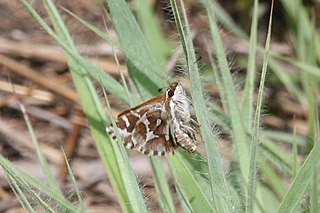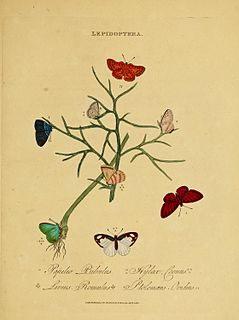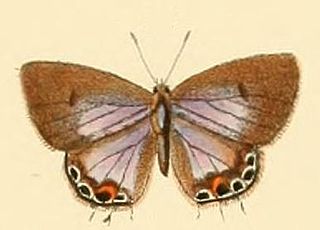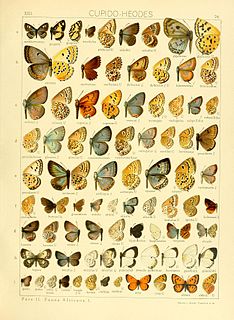
Kedestes barberae, or Barber's ranger, is a butterfly of the family Hesperiidae. It is found in southern Africa, from the Cape Province to Zimbabwe, Lesotho, Transvaal, the Orange Free State and KwaZulu-Natal.

Sarangesa phidyle, the orange flat or small elfin, is a butterfly of the family Hesperiidae. It is found from Botswana, south-west Africa, Saudi Arabia, Sudan. In South Africa it is found from the eastern Cape to Swaziland, KwaZulu-Natal, Mpumalanga and the Limpopo Province, the North West Province and Gauteng.
Spialia asterodia, the star sandman or Asterodia sandman, is a butterfly of the family Hesperiidae. It is found in South Africa from the western Cape to the southern part of the north Cape and across the east Cape to Lesotho, the Orange Free State, Swaziland, western KwaZulu-Natal, Mpumalanga, the Limpopo Province, the eastern North West Province and Gauteng. It is also present in southern Mozambique and Zimbabwe. The habitat consists of grassland and grassy areas in fynbos, Karoo and Bushveld.
Spialia dromus, the forest sandman, dromus grizzled skipper or large grizzled skipper, is a butterfly of the family Hesperiidae. It is found in tropical Africa. In South Africa it is found along the eastern Cape coast to KwaZulu-Natal into Swaziland. It is also present in Mpumalanga and the Limpopo Province into northern Gauteng and the extreme north-west of the North West Province.
Metisella malgacha, the grassveld sylph, is a butterfly of the family Hesperiidae. It is found in the Cape, Orange Free State, Lesotho, Transvaal, and KwaZulu-Natal in South Africa. The habitat consists of grassland and grassy areas in the fynbos and Karoo.
Borbo fallax, the false swift, is a butterfly of the family Hesperiidae. It is found in tropical Africa. In South Africa it is found in Swaziland, coastal KwaZulu-Natal, northern Gauteng and the Limpopo Province and the extreme north-east of the North West Province. The habitat consists of coastal bush and moist savanna.

Acraea lygus, the lygus acraea, is a butterfly of the family Nymphalidae. The species was first described by Herbert Druce in 1875. It is found in south-west Africa, Botswana, Kenya, Zambia. In South Africa it is found from the savannah in Northern Cape to the Limpopo Province and the north-west provinces. It is an occasional migrant to Mpumalanga.

Lachnocnema bibulus, the common woolly legs, is a butterfly of the family Lycaenidae. It is found in Sub-Saharan Africa. In South Africa it is found from the East Cape to KwaZulu-Natal, Swaziland, Mpumalanga, Gauteng, the Limpopo Province, and the North West Province.
Lachnocnema laches, the southern pied woolly legs, is a butterfly of the family Lycaenidae. It is found in coastal forests from the East Cape, along the coast of KwaZulu-Natal, inland to Swaziland, Mpumalanga, the Limpopo Province, and the North West Province along wooded hills and valleys. The habitat consists of savanna.

Cigaritis natalensis, the Natal bar or Natal barred blue, is a butterfly of the family Lycaenidae. It is found in South Africa, from the Eastern Cape along the coast to KwaZulu-Natal, Swaziland, the Free State, Mpumalanga, Gauteng, Limpopo and North West provinces, and part of the Northern Cape province. It is also present in Botswana.

Anthene definita, the common ciliate blue or common hairtail, is a butterfly of the family Lycaenidae. It is found in southern Africa.
Anthene contrastata, the mashuna hairtail, is a butterfly of the family Lycaenidae. It is found in eastern Africa, from South Africa, north to Ethiopia and Arabia.
Anthene talboti, the Talbot's hairtail or Talbot's ciliate blue, is a butterfly of the family Lycaenidae. It is found from South Africa to Zimbabwe, Kenya, Uganda and Tanzania. In South Africa it is found in the KwaZulu-Natal midlands, through to Orange Free State, Gauteng, Mpumalanga, the Limpopo Province and the North West Province. It is also present in the North Cape.

Anthene otacilia, the Otacilia hairtail or Trimen's ciliate blue, is a butterfly of the family Lycaenidae, found in Africa.

Tarucus sybaris, the dotted blue, is a butterfly of the family Lycaenidae. It is found in southern Africa.
Lepidochrysops ketsi, the ketsi blue, is a butterfly of the family Lycaenidae. It is found in South Africa.
Euchrysops dolorosa, the Sabi smoky blue, is a butterfly of the family Lycaenidae. It is found in South Africa, from the East Cape to KwaZulu-Natal, the eastern part of the Orange Free State, Mpumalanga, Gauteng, the Limpopo province, and the North West province.

Eicochrysops messapus, the cupreous blue, is a butterfly of the family Lycaenidae. It is found in Africa. In South Africa it is rare and only known from the northern part of the Limpopo province and northern KwaZulu-Natal.

Cupidopsis cissus, the common meadow blue, is a butterfly of the family Lycaenidae. It is found in most of Africa, south of the Sahara.

Actizera stellata, the red-clover blue, is a butterfly of the family Lycaenidae. It is found in South Africa, Ethiopia, southern Sudan, Kenya, Uganda, Zaire, Tanzania and northern Malawi. In South Africa it is found in the East Cape and the southern part of the Orange Free State.











